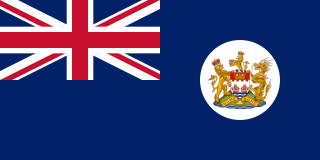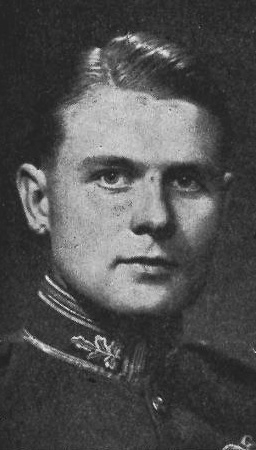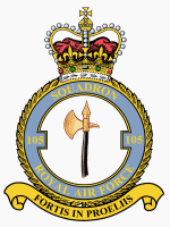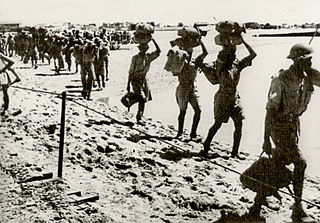This is the Operation Telic order of battle, which lists the British forces that took part in Operation Telic, including

Operation Granby, commonly abbreviated Op Granby, was the code name given to the British military operations during the 1991 Gulf War. 53,462 members of the British Armed Forces were deployed during the conflict. Forty-seven British personnel were killed during Op Granby and many more were injured during the hostilities there. The total cost of operations was £2.434 billion (1992), of which at least £2.049 billion was paid for by other nations such as Kuwait and Saudi Arabia; £200 million of equipment was lost or written off.

The Far East Fleet was a fleet of the Royal Navy which existed between 1952 and 1971.
An air officer is an air force officer of the rank of air commodore or higher. Such officers may be termed "officers of air rank". While the term originated in the Royal Air Force, air officers are also to be found in many Commonwealth nations who have a similar rank structure to the RAF.

British Forces Overseas Hong Kong comprised the elements of the British Army, Royal Navy and Royal Air Force stationed in British Hong Kong. The Governor of Hong Kong also assumed the position of the commander-in-chief of the forces and the Commander British Forces in Hong Kong took charge of the daily deployment of the troops. Much of the British military left prior to the handover of Hong Kong to China in 1997. The present article focuses mainly on the British garrison in Hong Kong in the post Second World War era. For more information concerning the British garrison during the Second World War and earlier, see the Battle of Hong Kong.
Muharraq Airfield is a military base located adjacent to Bahrain International Airport. It is run by the United States Navy (USN) and usually ships supplies in and out of the airport with many of them from other countries as well. The USN, the United States Marine Corps (USMC), the Ministry of Interior, and others run the security at the airfield. Often referred to as the nearby city of Manama, Muharraq Airfield was the last stop for most US troops being sent to fight in the War in Afghanistan (2001-2021), including with the multinational International Security Assistance Force.

The Aden Protectorate was a British protectorate in southern Arabia. The protectorate evolved in the hinterland of the port of Aden and in the Hadhramaut after the conquest of Aden by the Bombay Presidency of British India in January 1839, and which continued until the 1960s. In 1940, it was divided for administrative purposes into the Western Protectorate and the Eastern Protectorate. The territory now forms part of the Republic of Yemen.

Marshal of the Royal Air Force Samuel Charles Elworthy, Baron Elworthy, was a New Zealand-born senior officer in the Royal Air Force. He served as commander of a squadron of Blenheim bombers and then as a station commander during the Second World War. He became Chief of the Air Staff in the mid-1960s and implemented the cancellation of the TSR-2 strike aircraft and the HS681 military transport aircraft programmes. He also became Chief of the Defence Staff in which role he oversaw the evacuation from Aden in November 1967 and had to respond to the growing crisis in Northern Ireland in the late 1960s.
Air Chief Marshal Sir Hubert Leonard Patch, was a senior Royal Air Force commander.
Iraq Command was the Royal Air Force (RAF) commanded inter-service command in charge of British forces in Iraq in the 1920s and early 1930s, during the period of the British Mandate of Mesopotamia. It continued as British Forces in Iraq until 1941 when it was replaced by AHQ Iraq. It consisted of Royal Air Force, Royal Navy, British Army, Commonwealth and locally raised units, commanded by an RAF officer normally of Air Vice-Marshal rank.

The Aden Emergency, also known as the 14 October Revolution or as the Radfan Uprising, was an armed rebellion by the National Liberation Front (NLF) and the Front for the Liberation of Occupied South Yemen (FLOSY) against the Federation of South Arabia, a British Protectorate of the United Kingdom, which led to the proclamation of the People's Republic of South Yemen.

No. 105 Squadron was a flying squadron of the Royal Air Force, active for three periods between 1917 and 1969. It was originally established during the First World War as a squadron of the Royal Flying Corps and disbanded after the war. Reactivated shortly before the Second World War, it was inactive again after the conflict. During its second existence it was a bomber unit and had the distinction to be the first to operate the de Havilland Mosquito light bomber. During the 1960s it was reactivated again for six years to provide transport support for the British Army in the Aden Protectorate and the Far East.

The Royal Air Force College (RAFC) is the Royal Air Force academy which provides initial training to all RAF personnel who are preparing to become commissioned officers. The College also provides initial training to aircrew cadets and is responsible for all RAF recruiting along with officer and aircrew selection. Originally established as a naval aviation training centre during World War I, the College was established as the world's first air academy in 1919. During World War II, the College was closed and its facilities were used as a flying training school. Reopening after the War, the College absorbed the Royal Air Force Technical College in 1966.
AHQ Iraq was a command of the Royal Air Force (RAF).

Middle East Command was a command of the Royal Air Force (RAF) that was active during the Second World War. It had been preceded by RAF Middle East, which was established in 1918 by the redesignation of HQ Royal Flying Corps Middle East that had been activated in 1917 although a small Royal Flying Corps presence had been operational in the region since 1914.

No. 1417 Flight RAF was an independent flight of the Royal Air Force which existed between 1941 and 1993 at various times in a variety of roles. This Flight had probably the most interesting incarnations of all the independent aircraft flights of the Royal Air Force, introducing new technologies and operating complex fast jet aircraft in challenging and austere conditions, from the Arabian Peninsula to Central America.

The former Royal Air Force Near East Air Force, more simply known as RAF Near East Air Force, was the Command organisation that controlled all Royal Air Force (RAF) assets in the Eastern Mediterranean.
This is the order of battle for Operation Granby, the name given to the British Armed Forces deployment to the Middle East after the Iraqi invasion of Kuwait on 2 August 1990 and subsequent operations during the 1991 Gulf War.

Operation Appearance was a British landing in the British Somaliland Protectorate against troops of the Italian Army. The Italian conquest of British Somaliland had taken place seven months previously, in August 1940. The British had withdrawn from the protectorate after a delaying action at the Battle of Tug Argan. This withdrawal, after the disastrous conclusion of the Battle of France and the Italian declaration of war on 10 June 1940, had repercussions among British leaders. It led Prime Minister Winston Churchill to lose confidence in General Archibald Wavell, the British commander in the Middle East, which culminated in Wavell's sacking on 20 June 1941.
The Flag Officer, Middle East was a command appointment of the Royal Navy, established for two distinct periods from 1946–58 and then from c. 1962–1967. From c. 1946–1958 the appointment was located in the Suez Canal Zone or, after the Suez Crisis, in the Cyprus area; when reestablished from the post of Flag Officer, Arabian Seas and Persian Gulf, the focus was on the other side of Arabia. The headquarters moved from HMS Juffair in Bahrain to HMS Sheba, Steamer Point, Aden in 1962, and was located there until the British evacuation from Aden in 1967.










